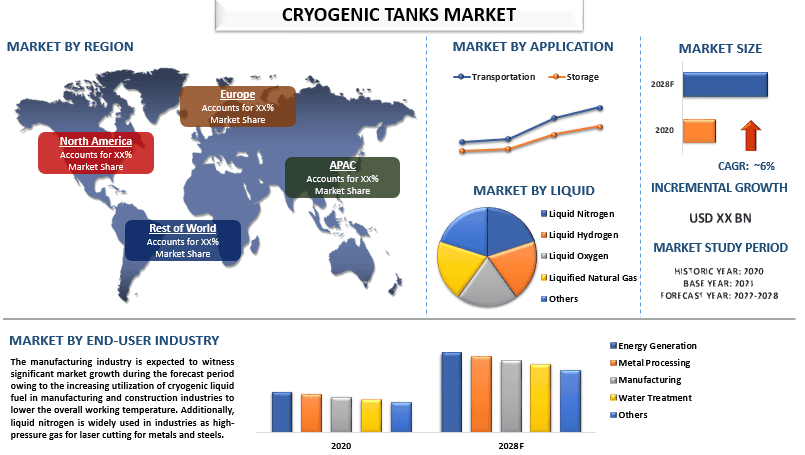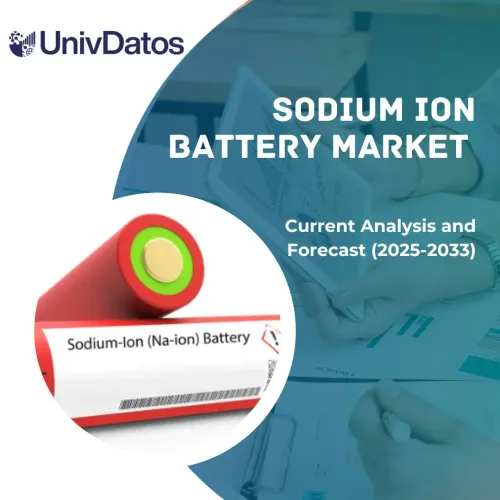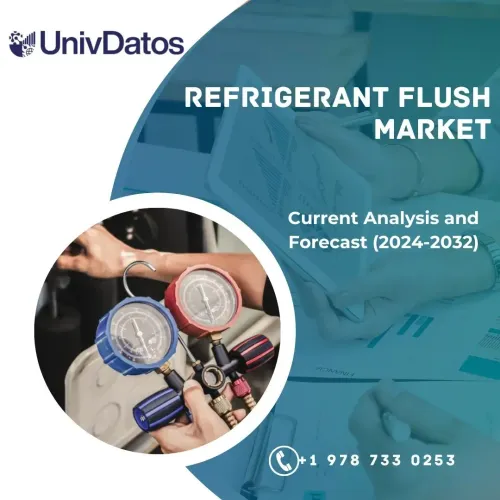- Home
- About Us
- Industry
- Services
- Reading
- Contact Us
Cryogenic Tanks Market: Current Analysis and Forecast (2022-2028)
Emphasis on Liquid (Liquid Nitrogen, Liquid Hydrogen, Liquid Oxygen, Liquified Natural Gas, and Others); Application (Storage and Transportation); End-industry (Energy Generation, Metal Processing, Manufacturing, Water Treatment, and Others); and Region/Country

The global Cryogenic Tanks Market is expected to grow at a significant rate of around 6% during the forecast period. Cryogenic tanks are used to store and facilitate the storage of natural gases including argon, nitrogen, hydrogen, oxygen, and others. The interior temperature of the liquids or fuels is kept constant by the design of the cryogenic tanks. Cryogenic fuel has recently been in high demand worldwide due to growing demand from the aerospace industry, manufacturing, energy, biomedical & health industries, as well as other industries and subsequently, there is an increase in the demand for cryogenic tanks to ensure the maximum safety of the fuel. Stainless steel or alloys are used to make cryogenic tanks and preserve the liquids. Also, cryogenic tanks have efficient insulation and could be used in various modes such as static, mobile, and transport and are expected to propel the market in the coming time.
Wessington Cryogenics, Air Products and Chemicals Inc., Cryofab Inc., Chart Industries Inc, ISISAN A.S, INOX India Pvt. Ltd., Linde Plc, Air Water Inc, FIBA Technologies, Inc., and Auguste Cryogenics are some of the key players in the market. Several M&As along with partnerships have been undertaken by these players to facilitate customers with hi-tech and innovative products/technologies.
Insights Presented in the Report
“Amongst liquid, liquid nitrogen category to witness higher CAGR during the forecast period”
Based on liquid, the market is segmented into liquid Nitrogen, liquid Hydrogen, liquid Oxygen, Liquified Natural Gas, and others. Liquid nitrogen is expected to witness significant growth during the forecast period owing to its extensive use in the manufacture the electronic products. Additionally, the healthcare industry uses liquid nitrogen extensively for cryotherapy to preserve cells and microorganisms as well as for snap-freezing tissue prior to cryostat sectioning or other analyses, which is projected to drive market growth. Additionally, because liquid nitrogen is noncorrosive, it can be utilized in a variety of applications, including the deflashing and grinding of specific materials like plastic and rubber, pulverization, food freezing, and others.
“Amongst application, the storage segment to hold a significant share in the market in 2020”
Based on application, the storage segment is expected to witness a significant CAGR during the forecast period due to the huge volume of stored gases including nitrogen, oxygen, helium, and hydrogen alongside other gases. The inner and outer walls of cryogenic tanks serve as an enclosure for the stored liquids and fuels and maintain the required temperature. Additionally, it is anticipated that the market expansion for the storage segment will be aided by the rising global demand for LNG and the requirement for cryogenic tanks to store the gas. For instance, according to Bloomberg, the global LNG demand was approximately 400 million metric tons in the year 2021 and is expected to reach 450 million metric tons by 2025 and is expected to support the market growth in the coming time.
“Asia-pacific to hold a significant share in the market”
In 2020, Asia-Pacific held a significant share of the global cryogenic tanks market. This is mainly due to the increasing demand for industrial gas by developing economies such as China and India. Additionally, the market for cryogenic fuel is anticipated to develop in several industries including automotive, energy, and power-generating sectors would lead to an increase in demand for cryogenic tanks. The increasing utilization of liquid nitrogen for the refrigeration of electronic products during the manufacturing process is expected to support market growth. Additionally, the government’s aid for switching from diesel and coal-based power plants to gas-based power plants in order to cut carbon emissions would require cryogenic tanks for the transportation and storage of natural gas and other usable fuel and are expected to increase the demand for the cryogenic tanks during the forecast period. In addition, the increasing adoption of cryogenic gas in the food and beverage industries, in the healthcare sector for the treatment of cryotherapy as well as in commercial, residential, and institutional development will propel the demand for cryogenic tanks.
Reasons to buy this report:
- The study includes market sizing and forecasting analysis validated by authenticated key industry experts.
- The report presents a quick review of overall industry performance at one glance.
- The report covers an in-depth analysis of prominent industry peers with a primary focus on key business financials, product portfolio, expansion strategies, and recent developments.
- Detailed examination of drivers, restraints, key trends, and opportunities prevailing in the industry.
- The study comprehensively covers the market across different segments.
- Deep dive regional level analysis of the industry.
Customization Options:
The global Cryogenic tanks market can further be customized as per the requirement or any other market segment. Besides this, UMI understands that you may have your own business needs, hence feel free to connect with us to get a report that completely suits your requirements.
Table of Content
Research Methodology for the Cryogenic Tanks Market Analysis (2022-2028)
Analyzing the historical market, estimating the current market, and forecasting the future market of the global cryogenic tanks market were the three major steps undertaken to create and analyze the adoption of cryogenic tanks in major regions globally. Exhaustive secondary research was conducted to collect the historical market numbers and estimate the current market size. Secondly, to validate these insights, numerous findings and assumptions were taken into consideration. Moreover, exhaustive primary interviews were also conducted, with industry experts across the value chain of the global Cryogenic tanks market. Post assumption and validation of market numbers through primary interviews, we employed a top-down/bottom-up approach to forecasting the complete market size. Thereafter, market breakdown and data triangulation methods were adopted to estimate and analyze the market size of segments and sub-segments of the industry pertains to. Detailed methodology is explained below:
Analysis of Historical Market Size
Step 1: In-Depth Study of Secondary Sources:
Detail secondary study was conducted to obtain the historical market size of the cryogenic tanks market through company internal sources such as annual reports & financial statements, performance presentations, press releases, etc., and external sources including journals, news & articles, government publications, competitor publications, sector reports, third-party database, and other credible publications.
Step 2: Market Segmentation:
After obtaining the historical market size of the cryogenic tanks market, we conducted a detailed secondary analysis to gather historical market insights and share for different segments & sub-segments for major regions. Major segments are included in the report as liquid, application, and end-industry. Further country-level analyses were conducted to evaluate the overall adoption of testing models in that region.
Step 3: Factor Analysis:
After acquiring the historical market size of different segments and sub-segments, we conducted a detailed factor analysis to estimate the current market size of the Cryogenic tanks market. Further, we conducted factor analysis using dependent and independent variables such as various liquids, applications, and end-industry of cryogenic tanks. A thorough analysis was conducted for demand and supply-side scenarios considering top partnerships, mergers and acquisitions, business expansion, and product launches in the cryogenic tanks market sector across the globe.
Current Market Size Estimate & Forecast
Current Market Sizing: Based on actionable insights from the above 3 steps, we arrived at the current market size, key players in the global cryogenic tanks market, and market shares of the segments. All the required percentage shares split, and market breakdowns were determined using the above-mentioned secondary approach and were verified through primary interviews.
Estimation & Forecasting: For market estimation and forecast, weights were assigned to different factors including drivers & trends, restraints, and opportunities available for the stakeholders. After analyzing these factors, relevant forecasting techniques i.e., the top-down/bottom-up approach were applied to arrive at the market forecast for 2028 for different segments and sub-segments across the major markets globally. The research methodology adopted to estimate the market size encompasses:
- The industry’s market size, in terms of revenue (USD) and the adoption rate of the cryogenic tanks market across the major markets domestically
- All percentage shares, splits, and breakdowns of market segments and sub-segments
- Key players in the global cryogenic tanks market in terms of products offered. Also, the growth strategies adopted by these players to compete in the fast-growing market
Market Size and Share Validation
Primary Research: In-depth interviews were conducted with the Key Opinion Leaders (KOLs) including Top Level Executives (CXO/VPs, Sales Head, Marketing Head, Operational Head, Regional Head, Country Head, etc.) across major regions. Primary research findings were then summarized, and statistical analysis was performed to prove the stated hypothesis. Inputs from primary research were consolidated with secondary findings, hence turning information into actionable insights.
Split of Primary Participants in Different Regions

Market Engineering
The data triangulation technique was employed to complete the overall market estimation and to arrive at precise statistical numbers for each segment and sub-segment of the global cryogenic tanks market. Data was split into several segments & sub-segments post studying various parameters and trends in the areas of liquid, application, and end-industry in the global Cryogenic tanks market.
The main objective of the Global Cryogenic tanks Market Study
The current & future market trends of the global cryogenic tanks market were pinpointed in the study. Investors can gain strategic insights to base their discretion for investments on the qualitative and quantitative analysis performed in the study. Current and future market trends determined the overall attractiveness of the market at a regional level, providing a platform for the industrial participant to exploit the untapped market to benefit from a first-mover advantage. Other quantitative goals of the studies include:
- Analyze the current and forecast market size of the cryogenic tanks market in terms of value (USD). Also, analyze the current and forecast market size of different segments and sub-segments
- Segments in the study include areas of liquids, application, and end-industry.
- Define and analysis of the regulatory framework for the cryogenic tanks
- Analyze the value chain involved with the presence of various intermediaries, along with analyzing customer and competitor behaviors of the industry.
- Analyze the current and forecast market size of the cryogenic tanks market for the major region.
- Major countries of regions studied in the report include Asia Pacific, Europe, North America, and the Rest of the World.
- Company profiles of the cryogenic tanks market and the growth strategies adopted by the market players to sustain in the fast-growing market
- Deep dive regional level analysis of the industry
Related Reports
Customers who bought this item also bought










